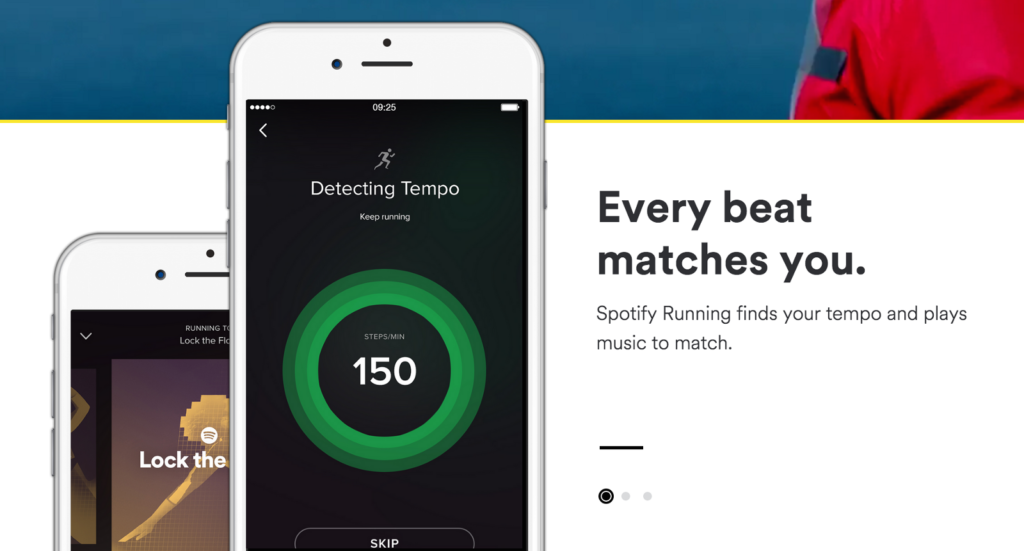Spotify Running is how motion-aware software is supposed to work. And it can still get better.
What was great about it?
As you start your run, Spotify Running detects your running cadence, which it maps to the tempo of its playlists. I clocked in at 160 BPM and started out with their Epic playlist.
I was unconvinced for the first 30 seconds of the run. The opening of that playlist builds slowly and it was too melancholy at the start. But after about a minute, the music grew to a resounding cinematic score, dialed in to each stride. I felt connected to the music in a new way — it felt like running through a movie.
Running is about rhythm. Finding a tempo that fits is a challenge, but once found you can settle in for miles of steady pace. Spotify Running helped me settle into that tempo right from the beginning. Each step felt like it was on time and in rhythm.
How did it change how I run?
Once Spotify Running determines your tempo, it maintains that BPM throughout. You can manually adjust it up or down (in increments of 5 BPM) but it remains otherwise unchanged. The steady rhythm caused a few interesting things to happen:
- I was hyper-aware of my cadence. I don’t usually pay attention to the way I run, I just run. With the music so closely matched to my running cadence I had immediate feedback when I sped up or slowed down. My natural instinct was to keep my pace pegged to the music.
- I started to think of running like cycling. Bikes have these great things called gears. Ideally, you keep your cadence and power relatively constant and use gears to adjust for climbing and descending hills. With Spotify Running, my cadence naturally wanted to stay constant. With power held constant as well, I found myself moderating San Francisco’s hills with the running equivalent of gears: stride length. This was an entirely new revelation for me.
- I reached a flow state far earlier in the run. As I alluded to above, I found it far easier to find my rhythm with Spotify Running than without. It usually takes me a mile or two to find a good tempo. After running to the music for about a half mile I was there.
What could make it even better?
Spotify’s challenge with this feature is in balancing the benefits of consistent tempo, which I’ve discussed above, with an athlete’s drive to push harder and faster (or their need to dial it down).
The feature lets you adjust your BPM manually by increments of five. I tried jumping to 165 but found it was beyond what I could maintain comfortably. Similarly, I’d expect 155 to be below a useful pace. Moreover, manual adjustments break the awesome tempo that the feature creates.
I could imagine Spotify solving for this in any number of ways. They could take advantage of built-in microphone / volume buttons on your headphones to adjust tempo on the fly. Or, if they’re able to detect changes in tempo of less than five BPM, they might detect slight variances of your pace and adjust accordingly. For example, if I was lagging one or two BPM behind over some period of time, they might infer that I’m struggling to keep up and drop the music down to match my pace. The tricky question there is whether, as a user, I’d like to have the tempo adjusted or prefer to keep the tempo constant as motivation.
Or, imagine an integration with Strava that detects whether I’m close to setting a PR for a given segment. As I get closer and closer to the end of the segment, the BPM clicks up and up, driving me faster and faster.
Motion-aware software comes of age
To this point, our fitness trackers and motion-sensor-enabled smartphones have been in the business of tracking what we’ve done. We know where we’ve been, how many steps we’ve taken, and how far and fast we’ve gone. But the tracking was the service.
Spotify Running takes tracking as the foundation and layers a novel and valuable service on top of it. And in many ways, the service alters the underlying activity by changing how the runner thinks about their tempo and finds their rhythm. In doing so, Spotify has delivered an exciting example of what the second generation of motion-aware software is capable of. Can’t wait to see more.

